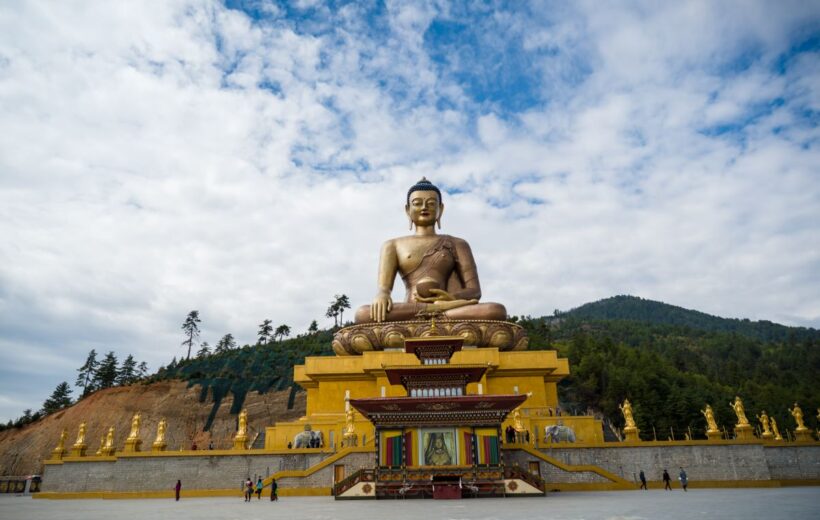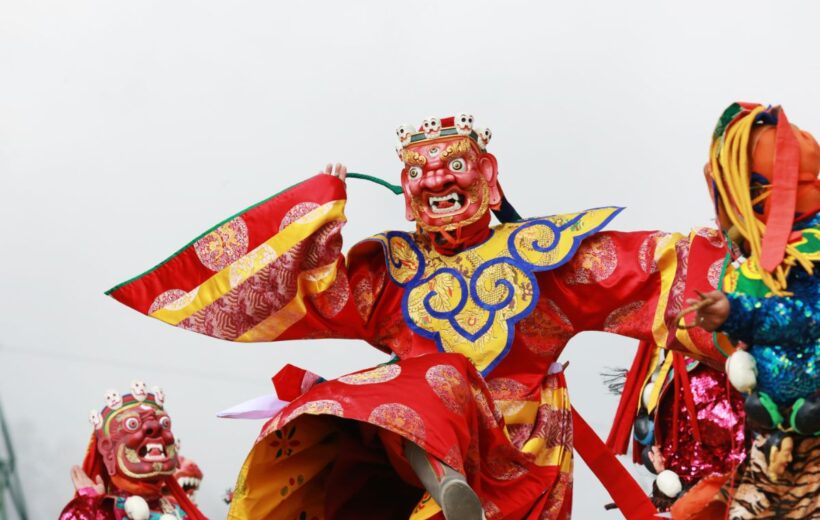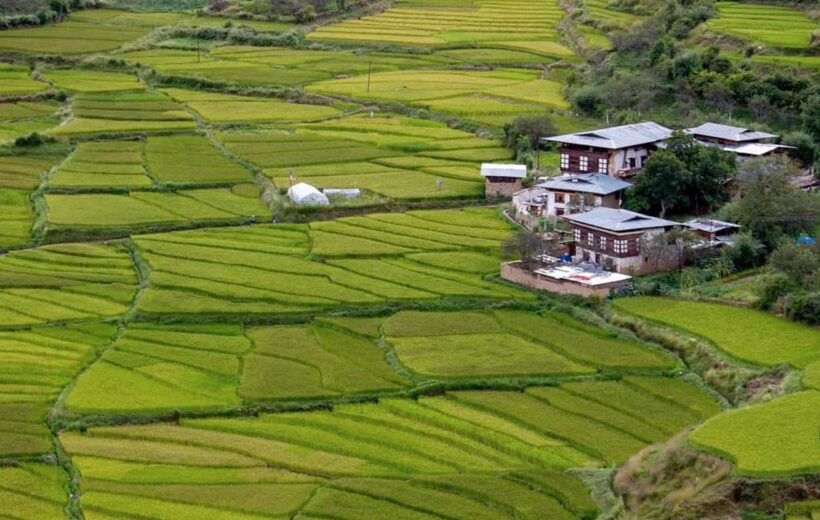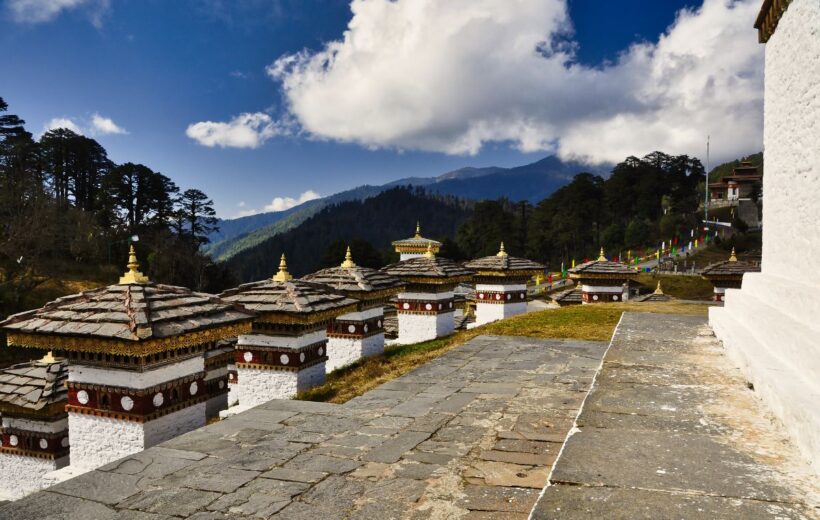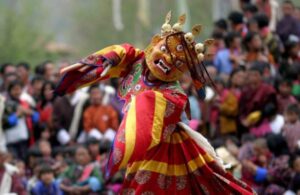From the monastery it’s a short walk down to the feeder road which will lead you to the village of Chamgang.
Overview
This six day trek takes you into an area adorned with a multitude of pristine, crystal clear lakes. As you walk amidst the shimmering lakes you’ll be treated to stunning views of the entire Himalayan mountain range and some of the world’s highest peaks including Mt. Everest, Jomolhari, Masang Gang, Jichu Drake, Gangche Ta and many more.
During the trek an entire day will be dedicated to visiting some of the more picturesque lakes and resting. The trail also takes you through several Bhutanese villages so you can get a good idea of traditional Bhutanese village life as you make your way back from the lakes.
While this is a somewhat strenuous trek, it is well worth the effort because of the tranquility and beauty of natural landscape that you will enjoy during the journey. The best time to embark on this trek is between April-June or September –October.
| Max Elevation | 4,720 m |
| Min Elevation | 2,250 m |
| Difficulty | Medium |
| Season | April, May, June, September, October |
| No. of Days | 6 Days |
Included
- Accommodation on Double/ Twin Sharing Basis
- Accommodation in twin sharing basis
- Meal Serve in Hotel as per hotel fix menu basis.
- Exclusive Vehicle for transfers & sightseeing.
- Vehicle will be available as per itinerary only. Not at disposal. 9am-5pm.after 5 pm extra charges apply.
- Base category room used in the package.
- All hotel taxes etc.
- English speaking GUIDE AND driver throughout the tour. Only Bhutan part.
- One Local Sim card.
- One ltr mineral water bottle during sightseeing time only.
Excluded
- Tipping
- Personal Insurance
- Any personal consumption made which is not included in the package
- Alcoholic drinks and special non Alcoholic cocktails, non-alcoholic beverages, aerated drinks and non-aerated drinks.
- Laundry charges at hotel stays
- Entrance fee at the historical monuments.
Tour Plan
Day 1: Gynekha – Gur
The trek starts at beautiful Gynekha village and begins with a short descent to the river. After crossing the river you start climbing until you reach a huge rock platform from where you have a picturesque view of the valley below. After another two hours you reach Gur, an area of yak pastures located just below the main trail.
Day 2: Gur – Labatama
On the second day, the trail takes you across the high ridges from where you can truly appreciate the rugged beauty of your surroundings and the mountain vegetation. The path winds through refreshing meadows adorned with wild flowers and asparagus (in spring). The first mountain pass you cross is marked by a huge cairn and gives a spectacular view of Kanjenjunga (Sikkim) and a number of the Bhutanese Himalayan peaks. As you descend the pass you will be able to see the entirety of the Dagala mountain range including meadows and yak herder camps. Once you have descended into the Labatama valley you begin climbing gradually through the valley, passing several yak herder huts before you arrive at Uthso Tsho. The campsite is right next to the lake.
Day 3: Labatama
This day will be dedicated to relaxing and recuperating at Labatama. It is an ideal to taker an excursion to any of three nearby lakes: Reli Tsho, Hen Tsho and Jama Tsho. Hikers are encouraged to take the opportunity to engage in some trout fishing as the location is ideal. Permits are required for fishing so you should request your tour operator to make the necessary arrangements beforehand.
Day 4: Labatama – Panka
The trail climbs along the western side of Dala Tsho up to a saddle at 4,520m. From here onwards you will have a fantastic view of the majestic Himalayan peaks all through the descent. The mountain peaks visible include Mt. Everest (Nepal), Mt. Kanchenjunga (Sikkim), Mt. Jomolhari, Mt. Jichu Drake, Mt. Tshering Gang, Mt. Khangbum, Mt. Masang Gang, Mt. Tsende Gang and Mt. Gangche Ta. If you want an even better view, you can climb a peak close to the saddle with an altitude of 4,720m. From the saddle the path descends, passing some yak herder huts to Doccha Chhu. You follow the river for a while, but stay higher up on the slope to reach Panka with ascents and descents along the way.
Day 6: Talakha – Chamgang
Frequently Asked Questions
Bhutan is a year-round destination. There are four seasons: summer (June to August), autumn (September to November), winter (December to February) and spring (March to May). But because of the range of altitudes in the country, and the influence of the north Indian monsoons, the climate is incredibly varied.
In the south, the humid, subtropical climate is fairly consistent year-round, with temperatures between 15oC and 30oC. Central Bhutan, with its temperate forests, has a more seasonal climate, with warm summers and cool, dry winters. The northern regions are much colder during winter. Because of the high altitude, mountain peaks are snowy year-round and the lower reaches remain cool in summer.
In summer, the Indian monsoon season runs from late June or July to late September, mostly affecting the southern regions. Most farming activities take place in the summer, when crops thrive in verdant landscapes.
Autumn, from late September or early October to late November, follows the rainy season. It is characterised by bright, sunny days and some early snowfall at higher elevations. It’s the season of feasts and festivals as farmers reap the fruits of their work.
From late November until March, the crisp, clear and sunny winter sets in, with frost throughout much of the country and snowfall common above elevations of 3,000 metres. The winter northeast monsoon brings gale-force winds at the highest altitudes through high mountain passes, giving Bhutan the name Drukyul, which means Land of the Thunder Dragon in Dzongkha (Bhutan’s national language).
Bhutan’s generally dry spring starts in early March and lasts until mid-April. It is a botanist’s delight, with nature in full bloom. Summer weather commences in mid-April with occasional showers and continues to late June.
Visitors of all nationalities, except those from India, require a visa before entering Bhutan. For all visitors, except those from Bangladesh and the Maldives, this visa must be applied for and approved in advance of travel. Visitors from Bangladesh and the Maldives also require a visa, but this can be applied for and approved either in advance of travel or upon arrival in Bhutan.
Visitors from India are able to apply for a permit but are required to hold an Indian passport or an Indian voter ID card. For Indian nationals under the age of 18, a passport or a birth certificate can be used to enter and they must be accompanied by a legal guardian.
Nationals from Switzerland and Thailand holding diplomatic or government-official passports are eligible for a visa at their port of entry.
A correctly input visa application can take up to five days to process.
The Sustainable Development Fee (SDF) is a daily levy paid by visitors to support Bhutan’s development. Since the kingdom first opened its doors in 1974, guests have played a critical role in our country’s growth.
The SDF is collected by the national exchequer and funds are allocated to various projects that create long-term, sustainable opportunities for the Bhutanese people, through free healthcare, education and training, upskilling the tourism and hospitality industry, improved infrastructure, environmental preservation and conservation, cultural preservation programmes and initiatives that support local businesses and economies. The SDF is also a vital means of maintaining the exceptional forest cover and carbon-neutrality for which our small nation is world-renowned and globally critical. The SDF also helps us to ensure that we can continue to offer guests tranquillity and an intimate experience.
The SDF is USD 100 per night for adults from all countries except for India. Children aged between 6 years and who have not yet turned 12 are eligible to pay USD 50 per night. Children who have not yet turned 6 years old do not have to pay any SDF.
The SDF for Indian nationals (showing a valid Indian passport or Voter ID card) is Nu. 1,200 (or the equivalent amount in Indian rupees) per person, per night. Children aged between 6 years and who have not yet turned 12 are eligible to pay Nu./INR 600 per night. Children who have not yet turned 6 years old do not have to pay any SDF.

